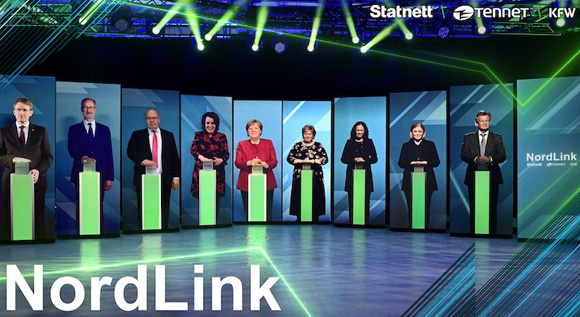0.25 miles under the sea
Up to 410 metres under the rough North Sea, the world’s longest underwater electricity cable is a unique 516 kilometre link between the German and Norwegian electricity grids.
 © BMWi / Susanne Erkisson
© BMWi / Susanne Erkisson
The master of ceremonies asks the guests of honour to hold the buzzer down for ten seconds. Ten seconds preceded by three years of construction work. Three years in which the total of 623 kilometres of “green” cable was laid from Wilster in Schleswig-Holstein through forests and fields, over hill and dale, across fjords and mountains – until it finally reached the transformer station at Tonstad in Norway. German Chancellor Angela Merkel, Norwegian Prime Minister Erna Solberg, German Economic Affairs Minister Peter Altmaier, the Minister-President of Schleswig-Holstein Daniel Günther, Norway’s Energy Minister Tina Bru, and representatives of the TSOs of both countries and of KfW bank pressed hard on their buzzers on 27 May 2021 to officially commission the NordLink Interconnector Route. It brings two perfect complements together: Norwegian hydropower and German wind power.
A DC highway for perfect balance
The two countries intend to use the NordLink DC highway to combine renewables-based electricity generation in the best possible way by exchanging superfluous electricity generated from renewables and thus ensuring security of supply. In view of the length of the cable and the high transmission capacity, low-loss DC technology is used to transport the power. Both ends of the two cables (plus and minus poles) are connected to transformer stations. These stations convert the electricity from DC to AC (or AC to DC, depending on the direction of flow), and feed it into the German/Norwegian AC transmission system. The link is being operated by Tennet, the German-Dutch system operator, KfW, the German state bank, and Statnett, the Norwegian system operator.
The cable, which has a transmission capacity of 1,400 megawatts, can be used by Germany to transport cheap wind energy to Norway when a lot of wind is available; this power can then be offered on the market or stored in water reservoirs. In return, Norway can send electricity from hydroelectric power stations to Germany at times when the feed-in from wind and solar power is low. This strikes a perfect balance between the flexibly deployable hydropower and the energy which is dependent on the wind and the sun, the feed-in of which can fluctuate depending on the weather. This could also reduce the electricity price in Germany, as the exchange of power will be better able to balance supply and demand at peak times.
Security of supply and Europe’s energy supply are growing together
Minister Altmaier flagged up the international significance of the project at the launch of the interconnector: “NordLink demonstrates the great importance of the electricity grid for the energy transition and is a prime example of outstanding cross-border cooperation between Norway and Germany. NordLink is a genuine collaborative project. Germany and Norway are providing a role model which extends far beyond Europe.” The new link is, he said, an important milestone in the integration of the European energy supply, progress on climate action, and greater sustainability, also for many future generations.
However, if climate-friendly and cheap electricity is to be able to travel from Norway to our major centres of consumption, the electricity grids in Germany will need to be expanded further. “This is a challenge”, Altmaier said. “But we are making progress, step by step.”
Norway has long been a key partner for Germany in the field of gas and oil. The successful commissioning of NordLink now marks the beginning of cooperation in the field of electricity. The project, which even experts described as “ambitious” and even “bold”, was completed on schedule and basically within the estimated budget. NordLink will enable more than 3.6 million households to be supplied with green electricity.
Further information
- Video by the Federal Ministry for Economic Affairs and Energy: “NordLink flagship project officially commissioned”
- Press release by the Federal Ministry for Economic Affairs and Energy: “Important progress on grid expansion: NordLink flagship project officially commissioned”
- Quote: Minister Altmaier at the NordLink opening ceremony

